- Home
- Rutland Water
Rutland Water Nature Reserve Photo Day
We visit Rutland Water, near Oakham in the county of Rutland, 2 or 3 times a year for birdwatching and wildlife photography. I wish it could be more, but they don't permit dogs, so we have to find someone to look after them each time.
We visit frequently, but we almost always get lost on the way.
There's one particular turn off the A1 that we mistakenly take, when we should ignore it and wait for the next one. You'd think we'd have learned by now!
Because of this detour, it normally takes us around 45 minutes to reach our starting point, The Anglian Water Birdwatching Centre at Egleton. If you're using a GPS, the best postcode to enter is LE15 8BT.
Walking all the way around the reservoir would be over 22 miles, which is too far for us at our age! Instead, we usually stick to the Nature Reserve at the western end, unless we're visiting specifically to see the Ospreys when they're breeding. I'll come back to talk about these magnificent birds of prey in a bit.
Let me start by sharing a story about a memorable day spent at Rutland Water for wildlife photography.
Rutland Water Photography - Group Meet Up
In February 2018, a Facebook group I was part of organized a trip to the nature reserve. Four other photographers joined me, though not everyone specialized in wildlife photography.
Since it was raining outside, we began at the viewing gallery above the visitor center. This gallery overlooked Lagoon 1, separated from the reservoir's South Arm by Brown's Island.
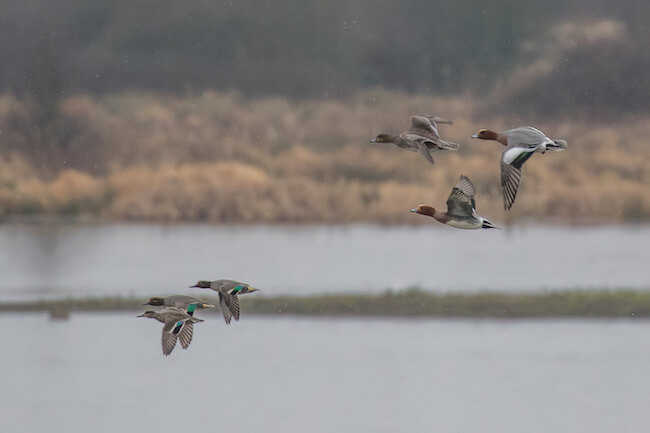 Teal (left) and Wigeon (right) flying over Lagoon 1
Teal (left) and Wigeon (right) flying over Lagoon 1The reserve is home to over 25,000 overwintering waterfowl. Most were too far away for great photos, so I decided to wait for them to fly closer. Thanks to the weather conditions, the birds stood out clearly against the murky background.
Jump to the rest of the story or read on for gear suggestions.
Lens Selection for Rutland Water Photography
One of the biggest challenges when photographing wildlife at Rutland Water is getting close enough to your subjects without disturbing them.
The vast, open spaces of the reserve mean that many birds and animals will keep their distance. This makes having the right lens setup crucial.
For the best results, I highly recommend using a super-telephoto lens in the 500-600mm range at minimum.
Zooms like the Sigma 150-600mm, Tamron 150-600mm, or Nikon 200-500mm are excellent affordable options that will allow you to fill the frame with your subjects.
If your budget permits, even longer primes like the Canon 800mm or Nikon 800mm can be absolute game-changers. The incredible reach gets you intimate frame-filling shots that simply aren't possible with shorter lenses. But for most of us they are out of price range, sadly.
Balancing Budget and Light
It's also worth considering a teleconverter or extender, which are accessories that increase your lens' focal length (e.g. turning a 400mm into a 560mm). However, cheaper extenders often have the downside of reducing the maximum aperture, which can make shooting in dim conditions very challenging.
On overcast days when light is scarce, a lens with a wider maximum aperture like f/4 or f/5.6 will be much better than narrower apertures of f/8 or smaller.
You can read more about camera settings here.
Faster lenses simply let in more light for higher shutter speeds and lower ISOs. So be prepared to make the tradeoff between light-gathering ability and reach if opting for an affordable super tele zoom.
No matter what lens you choose, I cannot overstate the importance of having enough focal length at Rutland. The ability to get close while keeping your distance is key to successful wildlife photography here.
Natural Drama!
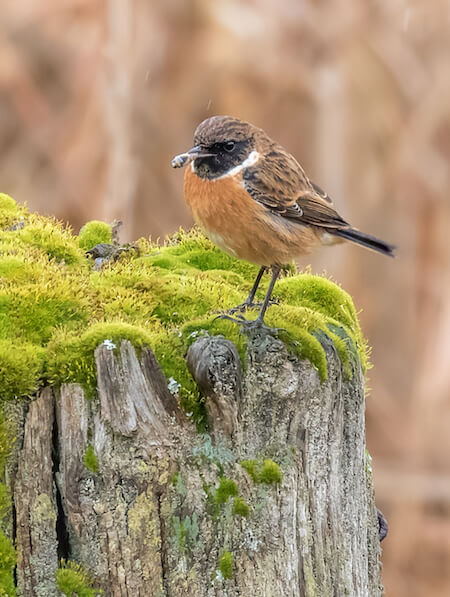 Male Stonechat with breakfast
Male Stonechat with breakfastAs I observed the scene, something moving in the nearby reeds grabbed my attention. After a closer look, I noticed a small bird, a Stonechat, busily catching insects and carrying them back to a mossy tree stump to enjoy for breakfast.
Nature's drama unfolded when we spotted a stoat slinking towards the reeds. Within minutes, it dashed out with a tiny bird clutched in its jaws! Fortunately, we continued spotting “our” Stonechat, suggesting it had narrowly avoided becoming the stoat's meal.
A murmur of voices caught my attention.
Apparently, someone in the group had spotted a Water Rail. Since I had never seen one before, I scanned the water's edge, searching for this elusive bird.
Thanks to the directions from a neighboring photographer, I finally found it and managed to snap a quick record shot – good enough to identify it, but not good enough to share, unfortunately.
Gradually, the rain let up, and we all ventured out towards the other three lagoons in this section of the reserve. Although the day remained gloomy with little light for photography, we were eager to see what other wildlife we could find.
Visiting The Hides
We visited the Redshank, Grebe, and Osprey hides overlooking Lagoon 2, but we didn't see much there. So, we moved on to the larger Lagoon 4 and its three hides.
From the Sandpiper hide, we quickly spotted a Grey Heron hiding in the reeds by the water's edge. Although the heron never fully revealed itself while we were there, one of the other ladies managed to capture a nice photo just after we left. That's how birdwatching often goes!
During our time in one of the hides, Mel Parsons, a member of our group, snapped a photo of me holding my 100-400mm lens. You can find this picture on the About Me page of the website.
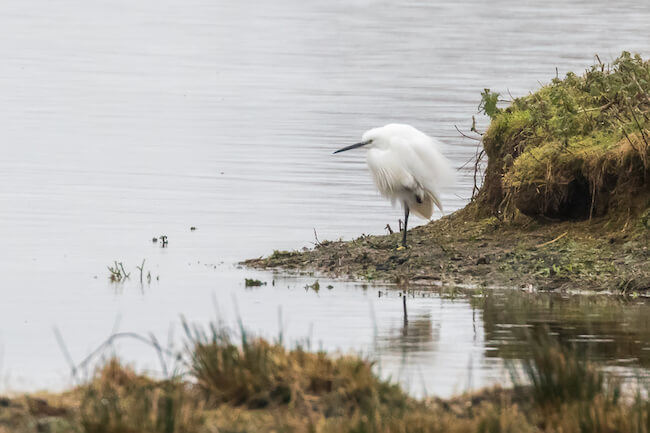 Little Egret
Little EgretWe caught sight of a Little Egret, its feathers puffed up to keep warm in the cold weather. Motionless as a statue, it only moved when spotting a fish. The egret kept us entertained until we headed to the Dunlin hide.
Later, the other ladies informed me that a Great White Egret had also been present on the lagoon while we were watching.
Although it would have been a new bird for me at the time, I've since seen many Great White Egrets during birdwatching and wildlife photography trips to Rutland Water and elsewhere in the region.
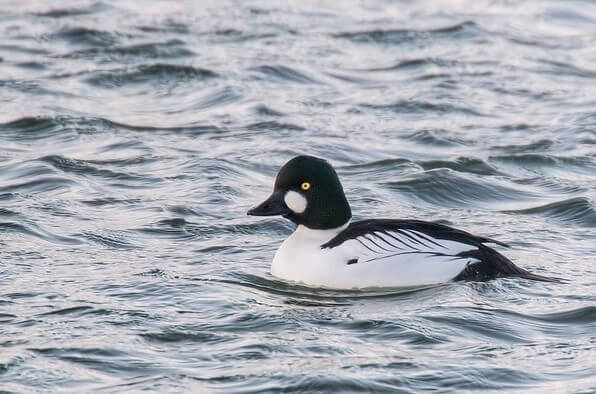 Male Goldeneye duck
Male Goldeneye duckThe usual birds were present on the water - Mallards, Wigeons, Tufted Ducks, Mute Swans, Greylag Geese, Coots, and a Great Crested Grebe. Among them was a single male Goldeneye, smart in his black and white plumage.
On a small stretch of land jutting out from the shoreline, a Carrion Crow was enjoying a fish. A solitary Lapwing and a couple of Shoveler ducks watched the crow from nearby.
A Rare Visitor
"There are two redheads out on the far side" came a voice from my left.
I had been so intent on the birds I hadn't noticed there was another person in the hide.
He was referring to female ducks of several species, but specified "Smew!" when I asked for clarification.
Kindly, he let me look through his spotting scope since the ducks were too far away for the naked eye. Although I couldn't photograph them, it was delightful to add Smew to my list of birds seen.
These beautiful birds only visit the UK in small numbers, mainly in the East and South-East regions. So it's a special moment when we spot one. Like many birds, the male Smew is the most attractive - mostly white with thin black lines reminiscent of cracked porcelain. We later learned there was a male at the reserve that day, though unfortunately it didn't show itself to us.
Back to the Birdwatching Centre
After visiting the hides, we headed back to the Birdwatching Centre and spent a few minutes checking out the feeding area. The ground below the feeders bustled with pheasants, moorhen and the usual small garden birds eagerly feasting on the free food on offer.
As 2 pm approached, we bid farewell to the rest of the group and made our way home after an enjoyable yet chilly and damp visit to Rutland Water for wildlife photography.
While you are here, you might like to check out our experience of taking one of Rutland Water's Osprey Cruises.
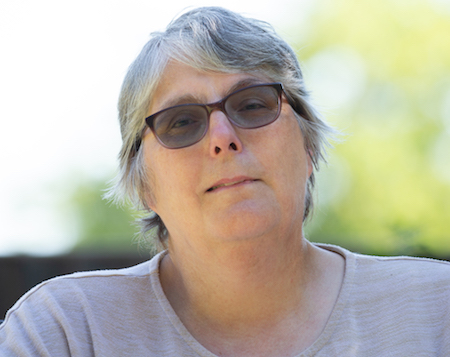
About the Author
Carol is a wildlife photographer and nature writer based in the East of England, with a passion for peaceful walks, patient observation, and capturing life’s quiet wonders.
Through her lens and words, she shares the stories of the natural world — from bluebells and butterflies to birds like the great crested grebe.
Get closer to UK nature
Subscribe to Wild Lens!
Want to discover more hidden walks and wildlife moments?
I’d love to share my latest nature finds, photo tips, and peaceful walk recommendations with you.
💌 Join my newsletter Wild Lens—it’s free, occasional, and always rooted in a love of the natural world.
Subscribe below and come exploring with me.
